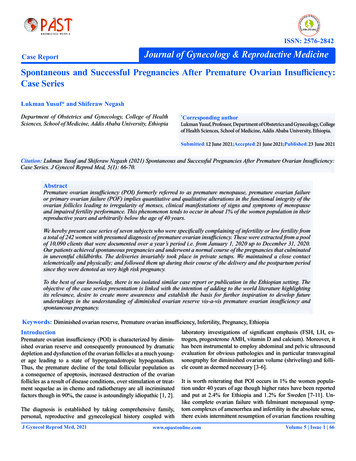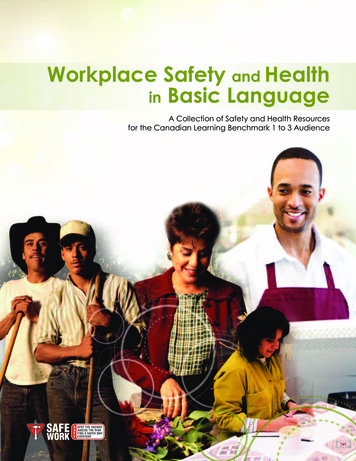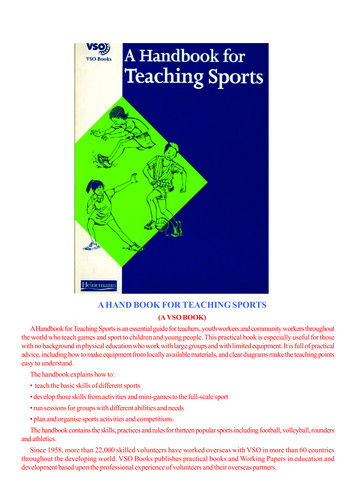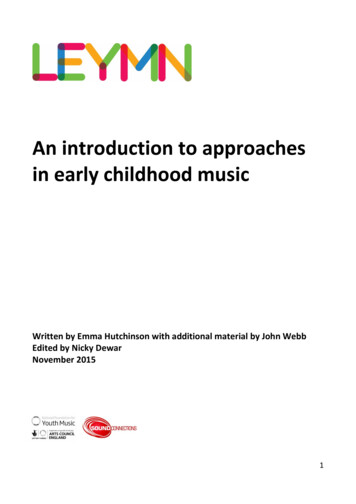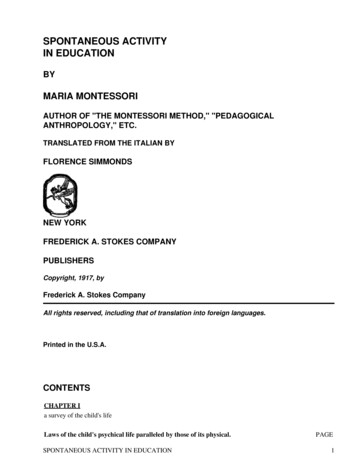
Transcription
SPONTANEOUS ACTIVITYIN EDUCATIONBYMARIA MONTESSORIAUTHOR OF "THE MONTESSORI METHOD," "PEDAGOGICALANTHROPOLOGY," ETC.TRANSLATED FROM THE ITALIAN BYFLORENCE SIMMONDSNEW YORKFREDERICK A. STOKES COMPANYPUBLISHERSCopyright, 1917, byFrederick A. Stokes CompanyAll rights reserved, including that of translation into foreign languages.Printed in the U.S.A.CONTENTSCHAPTER Ia survey of the child's lifeLaws of the child's psychical life paralleled by those of its physical.SPONTANEOUS ACTIVITY IN EDUCATIONPAGE1
The Project Gutenberg eBook of "Spontaneous Activity in Education", by Maria Montessori.Current objections to a system of education based upon "liberty"Hygiene has freed the infant from straps and swaddling clothes and left it free to developEducation must leave the soul free to developPrinciple of liberty in education not a principle of abandonment1259The liberty accorded the child of to-day is purely physical.Civil rights of the child in the twentieth century.Removal of perils of disease a step toward physical liberationSupplying the child's physical needs is not sufficientChild's social rights overlooked in the administration of orphan asylumsPoor child's health and property confiscated in the custom of wet nursingWe recognize justice only for those who can defend themselves1011121316How we receive the infants that come into the world.Home has no furnishings adapted to their small sizeSociety prepares a mockery for their reception in the shape of useless toysChild not allowed to act for himselfConstant interruption of his activities prevents psychical growthBodily health suffers from spiritual neglect1718202123With man the life of the body depends on the life of the spirit.Reflex action of the emotions on the body functionsChild's body requires joy as much as food and air2426CHAPTER IIa survey of modern educationThe precepts which govern moral education and instruction.Child expected to acquire virtues by imitation, instead of developmentDomination of the child's will the basis of education2829It is the teacher who forms the child's mind. How he teaches.Teacher's path beset with difficulties under the present systemAdvanced experts prepare the schemata of instructionSome outlines of "model lessons" used in the schoolsComparison of a "model lesson" for sense development with the Montessori methodExperimental psychology, not speculative psychology, the basis of Montessori teachingFalse conceptions of the "art of the teacher" illustrated by model lessons303333424446Positive science makes its appearance in the schools50Discoveries of medicine: distortions and diseases50CONTENTS2
The Project Gutenberg eBook of "Spontaneous Activity in Education", by Maria Montessori.Science has not fulfilled its mission in its dealings with children.Diseases of school children treated, causes left undisturbed52Discoveries of experimental psychology: overwork; nervous exhaustion57Science is confronted by a mass of unsolved problems.Laws governing fatigue still unknownToxines produced by fatigue and their antitoxinsJoy in work the only preventative of fatigueReal experimental science, which shall liberate the child, not yet born60626264CHAPTER IIImy contribution to experimental scienceThe organization of the psychical life begins with the characteristic phenomenon of attention.Incident which led Dr. Montessori to define her method67Psychical development is organized by the aid of external stimuli, which may be determinedexperimentally.Tendency to develop his latent powers exists in the child's natureEnvironment should contain the means of auto-education6972External stimuli may be determined in quality and quantity.Educative material used should contain in itself the control of errorQuantity of material determined by the advent of abstraction in pupilRelation of stimuli to the age of the pupil747779Material of development is necessary only as a starting point.Corresponds to the terra firma from which the aeroplane takes flight and to which it returns to restEstablishing of internal order, or "discipline"Psychical growth requires constantly new and more complex materialDifference between materials of auto-education and the didactic material of the schools81828385Psychical truths."Discipline" the first external sign of a psychical reaction to the materialInitial disorder in Montessori schoolsPsychical progress not systematic but "explosive in nature"Birth of individualityIntellectual crises are accompanied by emotionOlder child beginning in system, chooses materials in inverse orderCourse of psychical phenomena explained by diagrams87888991939697CONTENTS3
The Project Gutenberg eBook of "Spontaneous Activity in Education", by Maria Montessori.Tests of Binet and Simon arbitrary and superficialProblems of psychical measurementObserving the child's moral natureTransformation of a "violent" child and of a "spying" child in a Montessori schoolPolarization of the internal personality110110114115121Guide to psychological observation.WorkConductObedience122123123CHAPTER IVthe preparation of the teacherThe school is the laboratory of experimental psychologyQualities the new type of teacher must possess125128CHAPTER VenvironmentPhysical hygiene in the schoolThe requirements of psychical hygiene142143Free movement.Misconceptions of physical freedomAction without an aim fatiguesWork of "preservation" rather than "production" suitable to children148149150CHAPTER VIattentionAwakens in answer to an impulse of "spiritual hunger"Attention cannot be artificially maintained by teacherLiberty the experimental condition necessary for studying phenomena of attentionChild's perception of an internal development makes the exercise pleasant and induces him to prolongitExternal stimuli powerless without an answering internal forceA natural internal force directs psychical formationNew pedagogy provides nourishment for internal needsOrganization of knowledge in the child's mindTeacher directs, but does not interrupt phenomena of attentionMaterial offered should correspond to psychical needsCONTENTS1531551571581581611611621651664
The Project Gutenberg eBook of "Spontaneous Activity in Education", by Maria Montessori.CHAPTER VIIwillIts relation to attentionManifested in action and inhibitionOpposite activities of the will must combine to form the personalityPowers of the will established by exercise, not by subjectionPersistence in effort the true foundation of willDecision the highest function of the willDevelopment of will depends on order and clarity of ideasPower of choice, which precedes decision, should be strengthenedNeed of exercise for the will paralleled with need of muscular exerciseFallacy of educating the child's will by "breaking it""Character" the result of established will, not of emulation170170173174178180185185187189190CHAPTER VIIIintelligenceLiberating the child means leaving him to "his own intelligence"How the intelligence of the child differs from the instincts of animalsIntelligence the actual means of formation of the inner lifeHygiene of intelligenceIntelligence awakens and sets in motion the central nervous mechanismsIn an age of speed, man has not accelerated himselfSwift reactions an external manifestation of intelligenceAbility to distinguish and arrange the characteristic sign of intelligenceMontessori "sensory exercises" make it possible for the child to distinguish and classifyThe Montessori child is sensitive to the objects of his environmentEducational methods in use do not help the child to distinguishPower of association depends on ability to distinguish dominant characteristicsIndividuality revealed in association by similarityBy means of attention and internal will the intelligence accomplishes the work of associationJudgment and reasoning depend on ability to distinguishActivities of association and selection lead to individual habits of thoughtImportance of acquiring ability to reason for oneselfGenius the possession of maximum powers of association by similarityGenius of errors in association and reasoning which have impeded scienceThe consciousness can only accept truths for which it is "expectant"The intelligence has its peculiar perils, from which it should be 13214214222227233239CHAPTER IXCONTENTS5
The Project Gutenberg eBook of "Spontaneous Activity in Education", by Maria Montessori.imaginationThe creative imagination of science is based upon truth.Imagination based on reality differs from that based on speculationSpeculative imagination akin to original sinEducation should direct imagination into creative channels241243244Truth is also the basis of artistic imagination.All imagination based on sense impressionsNon-seasonal impressions—spiritual truthsEducation in sense perception strengthens imaginationPerfection in art dependent on approximation to truthExercise of the intelligence aids imagination245246248252254Imagination in children.Immature and therefore concerned with unrealitiesShould be helped to overcome immaturity of thoughtFalse methods develop credulity, akin to insanityPeriod of credulity in the child prolonged for the amusement of the adult"Living among real possessions" the cure for illusions255255258263264Fable and religion.Religion not the product of fantasyFable in schools does not prepare for religious teaching266267The education of the imagination in schools for older children.Environment and method oppressive"Composition" introduced to foster imaginationHow composition is "taught"Imagination cannot be forced269270271275The moral question.Contributions of positive science to moralityScience raises society to level of Christian standardsParents' failure to teach sex moralityProbable effects of experimental psychology in field of moralsExperimental psychology should be directed to the schoolsProgress of medicine and its relation to new psychologyChildish naughtiness a parental misconceptionInfant life different from the adultHindering the child's development a moral question for the adultNeed of the child "to touch and to act"275285288291292292295297299300CONTENTS6
The Project Gutenberg eBook of "Spontaneous Activity in Education", by Maria Montessori.How the adult prevents him from learning by doingConceptions of good and bad conduct in the schoolMutual aid a high crime in the schoolSurveillance for vicious habits originating in the schoolDeveloping the "social sentiment" in the school"A moral with every lesson" the teacher's aimInjurious system of prizes and punishments the school's mainstayThe fallacy of "emulation"Necessity of reforming the schoolGood conduct dependent on satisfaction of intellectual needsMere sensory education inadequateLove, the preservative force of lifeChristianity teaches necessity of mutual love302305306309310311312315321323325326329The education of the moral sense.Moral education must have basis of feelingAdult the stimulus by which child's feeling is exercisedHow and when the adult should offer affection331331332The essence of moral education.Importance of perfecting spiritual sensibilityNecessity of properly organized environmentHelping the child distinguish between right and wrong"Internal sense" of right and wrongMoral conscience capable of development336336336337340Our insensibility.Virtuous person and criminal not detected by contactThe War as an example of moral insensibilityInsensibility distinguished from death of the soulSpiritually, man must either ascend or die343345345346Morality and religion.Conversion, the sudden establishing of moral orderThe spirit enslaved by sentiments hostile to love347349The religious sentiment in children.Crises of conscience and spontaneous religious feelingSome original observations by Dr. Montessori351352CONTENTS7
The Project Gutenberg eBook of "Spontaneous Activity in Education", by Maria Montessori.SPONTANEOUS ACTIVITYIN EDUCATION[Pg 1]IA SURVEY OF THE CHILD'S LIFETopThe general laws which govern the child's psychical health have their parallel in those of its physicalhealth.—Many persons who have asked me to continue my methods of education for very young children onlines that would make them suitable for those over seven years of age, have expressed a doubt whether thiswould be possible.The difficulties they put forward are mainly of a moral order.Should not the child now begin to respect the will of others rather than his own? Should he not some daybrace himself to a real effort, compelling him to carry out a necessary, rather than a chosen, task? Finally,should he not learn self-sacrifice, since man's life is not a life of ease and enjoyment?Some, taking certain practical items of elementary education, which present themselves even at the age of six,and must be seriously envisaged at seven, urge their objection in this form: Now we are face to face with theugly specter of arithmetical tables, the arid mental gymnastics exacted by grammar. What do you propose?Would you abolish all this, or do you admit that the child must inevitably bow to these necessities?[Pg 2]It is obvious that the whole of the argument revolves round the interpretation of that "liberty" which is theavowed basis of the system of education advocated by me.Perhaps in a short time all these objections will provoke a smile, and I shall be asked to suppress them,together with my commentary on them, in future editions of this work. But at the present time they have aright to exist, and to be dealt with, although indeed it is not very easy to give a direct, clear and convincinganswer to them, because this entails the raising of questions on which everybody has firmly rootedconvictions.A parallel may perhaps serve to save us a good deal of the work. Indirectly, these questions have beenanswered already by the progress made in the treatment of infants under the guidance of hygiene. How werethey treated formerly? Many, no doubt, can still remember certain practises that were regarded asindispensable by the masses. An infant had to be strapped and swaddled, or its legs would grow crooked; theligament under its tongue had to be slit, to ensure its speaking eventually; it was important that it shouldalways wear a cap to keep its ears from protruding; the position of a recumbent baby was so arranged as not tocause permanent deformity of the tender skull; and good mothers stroked and pinched the little noses of theirnurslings to make them grow long and sharp instead of round and snub, and put little gold earrings throughthe lobes of their ears very soon after birth "to improve their eyesight." Such practises may be alreadyforgotten in some countries; but in others they obtain to this day. Who does not remember the various devicesSPONTANEOUS ACTIVITY IN EDUCATION8
The Project Gutenberg eBook of "Spontaneous Activity in Education", by Maria Montessori.for helping a baby to walk? Even in the first months after birth, at a period of life when the nervous system isnot completely developed, and it is impossible for the infant to coordinate its movements, mothers wastedseveral [Pg 3] half-hours of the day "teaching baby to walk." Holding the little creature by the body, theywatched the aimless movements of the tiny feet, and deluded themselves with the belief that the child wasalready making an effort to walk; and because it does actually by degrees begin to arch its feet and move itslegs more boldly, the mother attributed its progress to her instruction. When finally the movement had beenalmost established—though not the equilibrium, and the resulting power to stand on the feet—mothers madeuse of certain straps with which they held up the baby's body, and thus made it walk on the ground withthemselves; or, when they had no time to spare, they put the baby into a kind of bell-shaped basket, the broadbase of which prevented it from turning over; they tied the infant into this, hanging its arms outside, its bodybeing supported by the upper edge of the basket; thus the child, though it could not rise on its feet, advanced,moving its legs, and was said to be walking.Other relics of a very recent past are a species of convex crowns which were put round the heads of babieswhen they were considered capable of rising to their feet, and were accordingly emancipated from the basket.The child, suddenly left to himself after being accustomed hitherto to supports comparable to the crutches ofthe cripple, fell perpetually, and the crown was a protection to the head, which would otherwise have beeninjured.What were the revelations of Science, when it entered upon the scene for the salvation of the child? Itcertainly offered no perfected methods for straightening the noses and the ears, nor did it enlighten mothers asto methods of teaching babies to walk immediately after birth. No. It proclaimed first of all that Nature itselfwill [Pg 4] determine the shape of heads, noses, and ears; that man will speak without having the membraneof the tongue cut; and further, that legs will grow straight and that the function of walking will come naturally,and requires no intervention.Hence it follows that we should leave as much as possible to Nature; and the more the babe is left free todevelop, the more rapidly and perfectly will he achieve his proper proportions and higher functions. Thusswaddling bands are abolished, and the "utmost tranquillity in a restful position" is recommended. The infant,with its legs perfectly free, will be left lying full length, and not jogged up and down to "amuse" it, as manypersons imagine they are doing by this device. It will not be forced to walk before it is time. When this timecomes, it will raise itself and walk spontaneously.In these days nearly all mothers are convinced of this, and vendors of swaddling-bands, straps, and basketshave practically disappeared.As a result, babies have straighter legs and walk better and earlier than formerly.This is an established fact, and a most comforting one; for what a constant anxiety it must have been tobelieve that the straightness of a child's legs, and the shape of its nose, ears, and head were the direct results ofour care! What a responsibility, to which every one must have felt unequal! And what a relief to say: "Naturewill think of that. I will leave my baby free, and watch him grow in beauty; I will be a quiescent spectator ofthe miracle."Something analogous has been happening with regard to the inner life of the child. We are beset by suchanxieties as these: it is necessary to form character, to develop the intelligence, to aid the unfolding [Pg 5] andordering of the emotions. And we ask ourselves how we are to do this. Here and there we touch the soul of thechild, or we constrain it by special restrictions, much as mothers used to press the noses of their babies orstrap down their ears. And we conceal our anxiety beneath a certain mediocre success, for it is a fact that mendo grow up possessing character, intelligence and feeling. But when all these things are lacking, we arevanquished. What are we to do then? Who will give character to a degenerate, intelligence to an idiot, humanA SURVEY OF THE CHILD'S LIFE9
The Project Gutenberg eBook of "Spontaneous Activity in Education", by Maria Montessori.emotions to a moral maniac?If it were really true that men acquired all such qualities by these fitful manipulations of their souls, it wouldsuffice to apply a little more energy to the process when these souls are evidently feeble. But this is notsufficient.Then we are no more the creators of spiritual than of physical forms.It is Nature, "creation," which regulates all these things. If we are convinced of this, we must admit as aprinciple the necessity of "not introducing obstacles to natural development"; and instead of having to dealwith many separate problems—such as, what are the best aids to the development of character, intelligenceand feeling?—one single problem will present itself as the basis of all education: How are we to give the childfreedom?In according this freedom we must take account of principles analogous to those laid down by science for theforms and functions of the body during its period of growth; it is a freedom in which the head, the nose, andthe ears will attain the highest beauty, and the gait the utmost perfection possible to the congenital powers ofthe [Pg 6] individual. Thus here again liberty, the sole means, will lead to the maximum development ofcharacter, intelligence and sentiment; and will give to us, the educators, peace, and the possibility ofcontemplating the miracle of growth.This liberty will further deliver us from the painful weight of a fictitious responsibility and a dangerousillusion.Woe to us, when we believe ourselves responsible for matters that do not concern us, and delude ourselveswith the idea that we are perfecting things that will perfect themselves quite independently of us! For then weare like lunatics; and the profound question arises: What, then, is our true mission, our true responsibility? Ifwe are deceiving ourselves, what is indeed the truth? And what sins of omission and of commission must belaid to our charge? If, like Chanticleer, we believe that the sun rises in the morning because the cock hascrowed, what duties shall we find when we come to our senses? Who has been left destitute, because weourselves have forgotten "to eat our true bread"?The history of the "physical redemption" of the infant has a sequel for us which is highly instructive.Hygiene has not been confined to the task of anthropological demonstration, such as that which not only madegenerally known, but convinced every one, that the body develops spontaneously; because, in reality, thequestion of infant welfare was not concerned with the more or less perfect forms of the body. The realinfantile question which called for the intervention of science was the alarming mortality among infants.It certainly seems strange in these days to consider this fact: that, at the period when infantile diseases madethe greatest ravages, [Pg 7] people were not nearly so much concerned with infantile mortality as with theshape of the nose or the straightness of the legs, while the real question—literally a question of life anddeath—passed unobserved. There must be many persons who, like myself, have heard such dialogues as this:"I have had great experience in the care of children; I have had nine." "And how many of them are living?""Two." And nevertheless this mother was looked upon as an authority!Statistics of mortality reveal figures so high that the phenomenon may justly be called the "Slaughter of theInnocents." The famous graph of Lexis, which is not confined to one country or another, but deals with thegeneral averages of human mortality, reveals the fact that this terrible death-rate is of universal occurrenceamong all peoples. This must be attributed to two different factors. One is undoubtedly the characteristicfeebleness of infancy; the other the absence of protection for this feebleness, an absence that had becomeA SURVEY OF THE CHILD'S LIFE10
The Project Gutenberg eBook of "Spontaneous Activity in Education", by Maria Montessori.general among all peoples. Good-will was not lacking, nor parental affection; the fault lay hidden in anunknown cause, in a lack of protection against a dire peril of which men were quite unconscious. It is now amatter of common knowledge that infectious diseases, especially those of intestinal origin, are those mostdestructive to infant life. Intestinal disorders which impede nutrition, and produce toxins at an age when thedelicate tissues are most sensitive to them, were responsible for nearly the entire death-roll. These wereaggravated by the errors habitually committed by those in charge of infants. These errors were a lack ofcleanliness which would astound us nowadays, and a complete absence of any sort of rule concerning infantdiet. The [Pg 8] soiled napkins which were wrapped round the baby under its swaddling bands would be driedin the sun again and again, and replaced on the infant without being washed. No care was taken to wash themother's breast or the baby's mouth, in spite of fermentation so pronounced as to cause local disorder.Suckling of infants was carried out quite irregularly; the cries of the child were the sole guide whereby itsfeeding times, whether by night or day, were determined; and the more it suffered from indigestion and theresulting pains, the more frequently was it fed, to the constant aggravation of its sufferings. Who in those daysmight not have seen mothers carrying in their arms babies flushed with fever, perpetually thrusting the nippleinto the little howling mouth in the hope of quieting it? And yet those mothers were full of self-sacrifice andof maternal anguish!Science laid down simple rules; it enjoined the utmost possible cleanliness, and formulated a principle soself-evident that it seems astounding people should not have recognized it for themselves: that the smallestinfant, like ourselves, should have regular meals, and should only take fresh nourishment when it has digestedwhat has been given before; and hence that it should be suckled only at intervals of so many hours, accordingto the months of its age and the modifications of physical function in its development. No infant should everbe given crusts of bread to suck, as is often done by mothers, especially among the lower orders, to still itscrying, because particles of bread might be swallowed, which the child is yet incapable of digesting.The mothers' anxiety then was: what are we to do when the baby cries? They found to their astonishment aftera time that their babies cried [Pg 9] a great deal less, or indeed not at all; they even saw infants only a weekold spending the two hours' intervals between successive meals calm and rosy, with wide-open eyes, so silentthat they gave no sign of life, like Nature in her moments of solemn immobility. Why indeed should they crycontinually? Those cries were the sign of a state of things which must be translated by these words: sufferingand death.And for these wailing little ones the world did nothing. They were strapped up in swaddling clothes, and veryoften handed over to a young child incapable of responsibility; they had neither a room nor a bed of their own.It was Science which came to the rescue and created nurseries, cradles, rooms for babies, suitable clothes forthem, alimentary substances specially prepared for them by great industries devoted to the hygienicsustenance of infants after weaning, and medical specialists for their ailments; in short, an entirely new world,clean, intelligent, and full of amenity. The baby has become the new man who has conquered his own right tolive, and thus has caused a sphere to be created for him. And in direct proportion to the diffusion of the lawsof infantile hygiene, infant mortality has decreased.So then, when we say that in like manner the baby should be left at liberty spiritually, because creative Naturecan also fashion its spirit better than we can, we do not mean that it should be neglected and abandoned.Perhaps, looking around us, we shall perceive that though we cannot directly mold its individual forms ofcharacter, intelligence, and feeling, there is nevertheless a whole category of duties and solicitudes which wehave neglected: and that on these the life or death of the spirit depends.The principle of liberty is not therefore a principle of [Pg 10] abandonment, but rather one which, by leadingus from illusions to reality, will guide us to the most positive and efficacious "care of the child."A SURVEY OF THE CHILD'S LIFE11
The Project Gutenberg eBook of "Spontaneous Activity in Education", by Maria Montessori.The liberty accorded to the child of to-day is purely physical. Civil rights of the child in the twentiethcentury.—Hygiene has brought liberty into the physical life of the infant. Such material facts as the abolitionof swaddling bands, open-air life, the prolongation of sleep till the infant wakes of its own accord, etc., are themost evident and tangible proof of this. But these are merely means for the attainment of liberty. A far moreimportant measure of liberation has been the removal of the perils of disease and death which beset the childat the outset of life's journey. Not only did infants survive in very much greater numbers as soon as theobstacles of certain fundamental errors were swept away, but it was at once apparent that there was animprovement in their development. Was it really hygiene which helped them to increase in weight, stature,and beauty, and improved their material development? Hygiene did not accomplish quite all this. Who, as theGospel says, can by taking thought add one cubit to his stature? Hygiene merely delivered the child from theobstacles that impeded its growth. External restraints checked material development and all the naturalevolution of life; hygiene burst these bonds. And every one felt that a liberation had been effected; every onerepeated in view of the accomplished fact: children should be free. The direct correspondence between"conditions of physical life fulfilled" and "liberty acquired" is now universally and intuitively recognized.Thus the infant is treated like a young plant. Children to-day enjoy the rights which from time immemorialhave been accorded [Pg 11] to the vegetables of a well-kept garden. Good food, oxygen, suitable temperature,the careful elimination of parasites that produce disease; yes, henceforth we may say that the son of a princewill be tended with as much care as the finest rose-tree of a villa.The old comparison of a child to a flower is the reality to which we now aspire; though even this is a privilegereserved for the more fortunate children. But let us beware of so grave an error. The babe is a man. Thatwhich suffices for a plant cannot be sufficient for him. Consider the depth of misery into which a paralyzedman has
Incident which led Dr. Montessori to define her method 67 Psychical development is organized by the aid of external stimuli, which may be determined experimentally. Tendency to develop his latent powers exists in the child's nature 69 Environment should contain the means of auto-education



